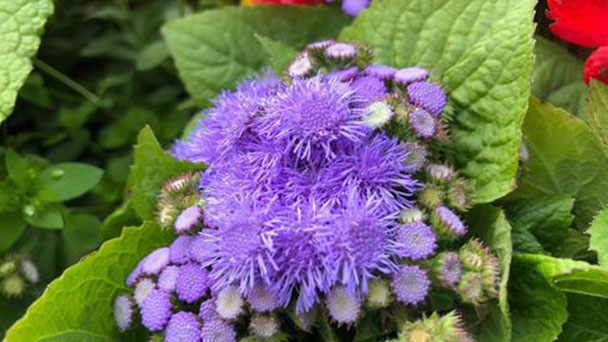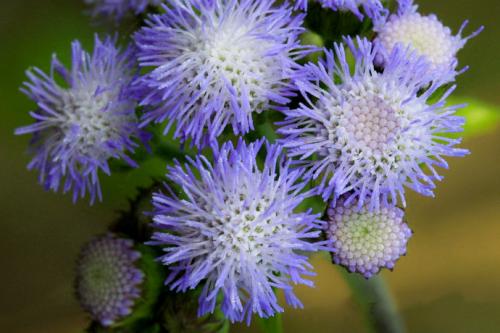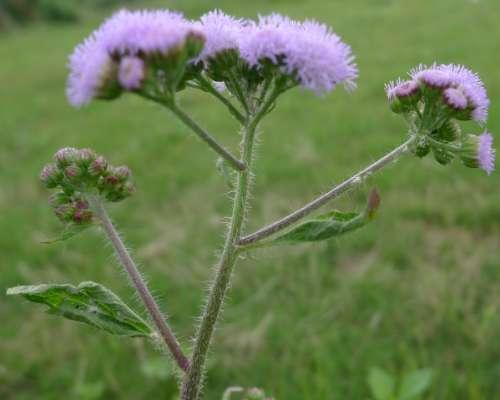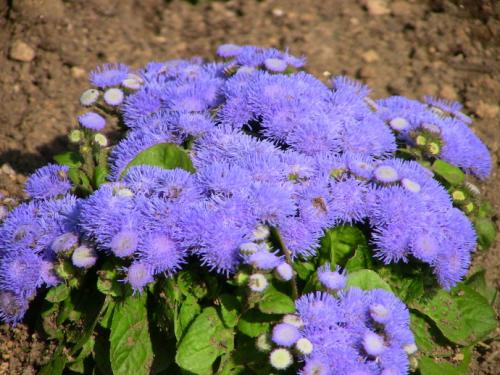Floss Flower (Ageratum Houstonianum) Profile: Plant Info & Care Guide
Written by Maggie
Dec 07 2021

Floss Flower (Ageratum houstonianum), also called Blue maudlin, Bluemink, Flossflower, Blueweed, Mexican ageratum, Mexican paintbrush, Pussy foot, is an annual herb, having no distinct taproot, an erect, unbranched stem, propagated by seed. The introduction and cultivation of Floss Flower has a history of 150 years. There are many varieties of cultivated horticulture. At present, it is widely distributed in Africa, Asia (India, Laos, Cambodia, Vietnam, etc.) and Europe.
Floss Flowers like warm and sunny environments. They grow and flower all year round.
Floss Flower Picture

Characteristics of Floss Flowers
Floss Flowers are 30 -- 70 cm or sometimes up to 1 m tall, without obvious tap roots. Stem or from upper or from lower branches and branches obliquely ascending, or lower stem branches prostrate and nodal adventitious roots. Stem base diameter us to 6 mm. All stems and branches are pale red or green or straw yellow, white tomentose or thin cotton-wool, stem and branch upper and axillary branchlets on the hair often dense, open. Leaves of floss flower are opposite, sometimes distally subalternate, broad or long ovate, or triangular-ovate, middle stem 2 -- 6 cm long, 1.5 -- 3.5 cm wide, or equal in length and width.
Leaves of Floss Flower are tapered or smaller from middle upward and downward and axillary. All leaf petioles are 0.7 -- 3 cm long, margin with the rules of the circular saw, big or small, or tight or loose, apex rounded or acute, base of heart-shaped or truncation, three base vein or not obvious veins 5, sparse or dense white pilose on both sides, and under the pulse was MAO, upper leaf petiole, altar young twigs and young branches and leaves of petiole is usually carried out of the long white hairs. Floss Flower has 5-15 inflorescences or more arranged in corymbs or compound corymbs 2 -- 4 cm in diameter on top of stem and branches; Pedicels are densely pilose or dust-pilose.
The Involucre of Floss Flower is campanulate, 6 -- 7 mm in diameter; Involucral bracts are 2-tiered, narrowly lanceolate, 4 -- 5 mm long, entire, apex long acuminate, outer covered with more glandular pilose. Corolla is 2.5 -- 3.5 mm, leaves lavender, 5-lobed, lobes pubescent outside. Achene of Floss Flower is black, 5-longitudinally ribbed, 1.5 -- 1.7 mm long. Coriolus is lamellar, 5, separated, lamellar oblong or lanceolate, full length 2 -- 3 mm, apex acuminate, sometimes apex truncate, but not acuminate, only 0.1 -- 0.15 mm long.
Ecological Habits of Floss Flowers
Floss Flowers like warm and sunny environments, are not hardy to cold, and their growth is slightly inhibited in hot summer. The requirement of soil is not strict, and the requirement of soil moisture and fertilizer is moderate. Excessive moisture or nitrogen fertilizer will lead to poor flowering. Floss Flower is adaptable and resistant to pruning.
When to Grow Floss Flowers
Plant nursery starts outdoors from late spring to early summer after all danger of frost is past. Sow seed indoors 8 to 10 weeks before your last average frost date. Seeds can be sown directly outdoors after your average last frost date; however, plants will not bloom until late summer or fall. Ageratums are heat lovers and will fail to thrive if it’s too cold.
Where to Grow Floss Flowers
In a bed or container with rich, well-draining soil that will stay evenly moist.
How to Grow and Vare for Floss Flower
Floss Flower Size & Growth
The majority of cultivars in floss flowers range from 6 to 24” inches tall clumped in a dense mound 6 to 18” inches wide.
A few cultivars of Floss Flowers, such as ‘Blue Horizon’ and classic ‘Blue Danube’ achieve a height of 30″ to 36” inches. It generally requires 60 to 100 days to bloom after germinating.
The toothed leaves are oval in shape, measuring up to 2” inches long. Its stems are round and green with soft hairs.
Floss Flower Blooming & Fragrance
Foss flowers are famous for their true blue blooms, which last from May to November in parts of the US.
It gets its common name from the feathery, pom-pom shaped blue flowers which have a pleasant fragrance and tend to cover the plant.
Floss Flowers produce fuzzy, tufted flowers in rounded, dense flower heads adding a desirable blue flower color to the garden, even in partial shade.
Between 5 and 15 florets grow on each flower cluster. They can grow from 12″ to 39″ inches tall.
The original medium blue has been expanded through cultivation to include bicolor, burgundy, lavender, mauve, pink, powder blue, purple, red, and white.
Its seeds are tiny, black or brown, and have five whitish scales that allow them to be wind-down.
Floss Flower Humidity Requirements
Floss Flowers like humid or semi-dry climates, and the relative temperature of air in the growth environment is required to be between 50 and 70%. If the relative humidity of air is too low, the lower leaves turn yellow and fall off, and the upper leaves are dull.
Floss Flower Temperature Care
Floss Flowers are well adapted to light. Put in indoor maintenance, put in the place that has bright light as far as possible, wait for a place like the sitting room with good daylighting, bedroom, study. Floss Flower likes a wet or semi-dry growth environment, the relative temperature of the air in the growth environment is required to be 50 ~ 70%, the relative humidity of the air is too low at the lower part of the leaves yellowing, falling off, the upper leaves dull. The thistle is not cold resistant. Before the frost comes, Floss Flower should be moved indoors and put in a place with sufficient sunshine. The temperature at night should be above 5℃, and the temperature during the day should be 10℃-15℃, so it can grow and blossom normally. Every 3-5 days water 1 time, every half a month water dilute cake fertilizer. After indoor maintenance for a period of time, it is necessary to move it to the outdoor shade (thermal insulation conditions in winter) of the place for maintenance for a period of time, so alternate.
Since Floss Flowers are native to subtropical areas, they have strict requirements for winter temperature and stop growing when the ambient temperature is below 8℃. The light adaptation ability is strong. Put in indoor maintenance, put in the place that has bright light as far as possible, wait for a place like the sitting room with good daylighting, bedroom, study. After indoor maintenance for a period of time (a month or so), it is necessary to move it to the outdoor shade (winter heat preservation conditions) of the place for maintenance for a period of time (a month or so), so alternate.

How to Propagate Floss Flowers
Floss Flowers are commonly propagated by sowing and cutting. Not cold, full light, medium water fertilizer, sandy loam, soil requirements are not strict.
Floss Flower Propagation from Seed
The seed of Floss Flower is small, and the sowing requires careful work. In general, in early February in the greenhouse sowing, but also in early April in the open field sowing. Cultivation soil should be to farm fertilizer, garden soil half, mixed with a small amount of leaf rot soil, mixed evenly after sieving. A small amount of seedlings can be used in a pot (a large number of seedlings can make a bed), the cultivation soil into the basin, after compaction pouring permeable, to be water seepage, the seed evenly spread on the wet soil. The soil should not be too thick to cover the seeds tightly. Keep the basin soil moist. The seedlings can emerge in about 10 days. Seedling has 2 pairs of true leaves seedling, with a small plastic nutrition bowl, each pot planted 1 plant. The seedlings grow slowly.
Floss Flower Propagation from Cutting
For early forming and early flowering, cuttings can be used to raise seedlings. Cuttage seedling to prepare a large mother Floss Flower, put in the greenhouse in winter, early spring to take strong branches, retain 2-4 true leaves, do not leave growing points. The branch length is 5-6 cm, the cutting mouth should be in the section, along with the cutting with insert. Cuttage depth for cuttings length of 1/3-1/2. High temperature season, cuttings put in the shade to prevent high temperature and insolation. Cutting seedling except winter low temperature, other growing season can be carried out, easy to survive.
Disease Control of Floss Flower
Floss Flowers are often affected by root rot, rust, and night moths and mealworms. Root rot was sprayed with 10% antimicrobial 401 acetic acid solution diluted 1 000 times, and rust was sprayed with 50% rustrin wettable powder diluted 2000 times. The insect pests are sprayed with 90% trichlorfon diluted 1000 times.
Distribution of Floss Flower
Floss Flowers are native to Mexico and adjacent areas. The introduction and cultivation has a history of 150 years. There are many varieties of cultivated horticulture. At present, Floss Flower is widely distributed in Africa, Asia (India, Laos, Cambodia, Vietnam, etc.) and Europe. C
Floss Flowers are cultivated or cultivated in Guangdong, Guangxi, Yunnan, Sichuan, Jiangsu, Shandong and Heilongjiang provinces of China.
Floss Flower Uses
Landscape Uses
Floss Flower can be used for flower beds, flower paths, clumps and ground covers for viewing and beautifying the environment.
Floss Flower clusters have good coverage effects, and are commonly used for flower observation in summer and autumn. They are excellent flower beds. Floss Flowers can also be planted in clusters or patches on forest margins and grassland edges, and dotted in rock gardens or pot plants. Floss Flowers are used as flower beds, ground covers, windowsill flower beds, flower borders, potted plants, hanging baskets, cut flowers, etc.
Medicinal Uses
Floss Flower is used as a whole herbal medicine. It has a slightly bitter and cool taste, and has the effect of clearing away heat and detoxification. In the Americas (Guatemala), whole grass is used to reduce inflammation and for sore throats.

Latest Updated
- Benefits of Bugleweed - 7 Science-backed Health Benefits
- Bugleweed Dangers & Side Effects - Is It Poisonous?
- How to Plant Evergreen Trees - What You Should Know
- When to Plant Evergreens - Grow Guide for Evergreen Trees
- 12 Wonderful Evergreen Shrubs for Your Garden
- 12 Popular Evergreen Plants with Pictures for Beginners
- When And How To Prune A Lilac Bush Like a Pro
- How to Grow & Care for Lilac Vine (Hardenbergia Violacea)
- Japanese Lilac Tree (Syringa Reticulata) Care & Propagation Guide
- Shumard Oak Pros and Cons - What to Know
Popular Articles
- Winter maintenance of Antirrhinum Majus
- How to Grow Terminalia Mantaly Tree
- How to Grow and Care for Crossostephium Chinense
- How to grow Antirrhinum Majus in spring
- Peristeria Elata (Dove Orchid) Profile: Info & Care Guide
- Underwatered Snake Plant (Sansevieria Trifasciata) - Signs And How To Fix
- How to Care for Brazilian Jasmine Plant (Mandevilla Sanderi)
- How to Grow & Care for Graptopetalum Purple Delight in Summer
- Rosa Chinensis (China Rose): Plant Growing & Care Tips
- How to Care for Baby Sun Rose (Aptenia Cordifolia)